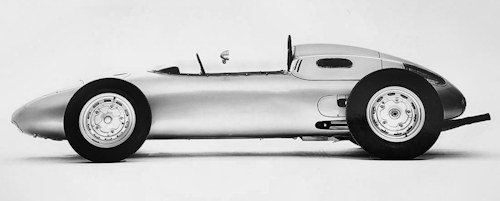Porsche 787 F1 F2 car
 | |
Production period: | 1960 to 1961 |
Class : | race car |
Body versions : | monoposto |
Engines: | Gasoline :1.5 liters (139 kW) |
Length: | 3600 mm |
Width: | 1520 mm |
Height: | 900 mm |
Wheelbase : | 2300 mm |
Curb weight : | 450 kg |
previous model | Porsche 718 |
successor | Porsche 804 |
The Porsche 787 is a Formula racing car of Porsche KG , which was used in the 1960 Formula 2 and 1961 Formula 1 season .
History
Porsche modified its successful 1500 RSK race-sports vehicle with four cylinder, four camshaft engine into a center-seat Spyder in 1957. Fully enclosed vehicles were permissible under Formula 2 regulations at the time. Its Grand Prix debut was a success: Edgar Barth was fastest in practise and won the race at the Nurburgring in Germany on August 4, 1957. In 1958, at the Grand Prix of Europe in Reims, France, Jean Behra won yet again. The season was closed out by a second place at the Nurburgring and a victory at Avus, Germany, which spurred Porsche to develop a purebred monoposto (literally'single seat') race car.
Porsche aimed for Formula 2 victories with this car, the Type 787, during 1960.
At Aintree in England, British drivers Stirling Moss and Graham Hill, along with Swede Joakim Bonnier, won a triple crown, while Porsche also won at Nurburgring, Zeltweg (Belgium), and Modena (Italy). Despite fierce competition from Lotus, Cooper, and Ferrari, these drivers, along with Barth and Hans Herrmann, Wolfgang Count Berghe von Trips, Bonnier, and Dan Gurney, won the coveted 'Coupe des Constructeurs', the unofficial Formula 2 World Championship for Makes, in 1960.
A year later, new Formula I rules presented Porsche with a new opportunity: in 1961, these modified single-seaters were used as the company's Grand Prix entry. For the 1961 season, the capacity for Formula 1 vehicles was limited to 1.5 liters. Porsche saw in the possibility for an entry, because the new regulations hardly differed from the previous Formula 2 . Here the manufacturer had already been able to celebrate successes with Edgar Barth on the Porsche 550 A Spyder and Jean Behra on the Porsche 718 .
The Porsche 787 was then no more than a base several-year-old Porsche 718/2 Monoposto . This was driven by the so-called Fuhrmann engine, which made up to 190 hp (139 kW) at 8000 / min. In practice, Porsche could not prevail against the dominating Ferraris , driven by Wolfgang Graf Berghe of Trips and Phil Hill , who became world champion. Best Porsche driver was Dan Gurney as third in the championship (fourth, if you count the fatal accident of trips). For the Formula 1 season 1962 , an eight-cylinder model was built with the Porsche 804 , which replaced the 787th
Rating
Technical
-
Porsche 787 Technical data (1960-1961)
Engine:
4-cylinder boxer engine (four-stroke) (type 547/6)
displacement:
1498 cc
Bore × stroke:
85.0 × 66.0 mm
Power at 1 / min:
139 kW (190 hp) at 8000
Max. Torque at 1 / min:
147 Nm at 6500
Compression:
10.3: 1
Valve control:
two overhead camshafts each , vertical shaft control
Cooling:
Air cooling (blower)
Transmission:
6-speed gearbox with limited slip differential , rear-wheel drive
brakes:
Two circular drum brakes
Front suspension:
Crank trailing arm
Rear suspension:
sloping double wishbones
Front suspension:
Square torsion bars
Rear suspension:
Coil springs, double-acting shock absorbers
Body:
Aluminum body with tubular frame
Track front / rear:
1300/1330 mm
Wheelbase :
2300 mm
Tires rim:
VA: 5.50-15 R J × 15
HA: 6.00-15 R J × 15Dimensions L × W × H:
3600 × 1520 × 900 mm
Curb weight :
450 kg
maximum speed:
250 km / h




